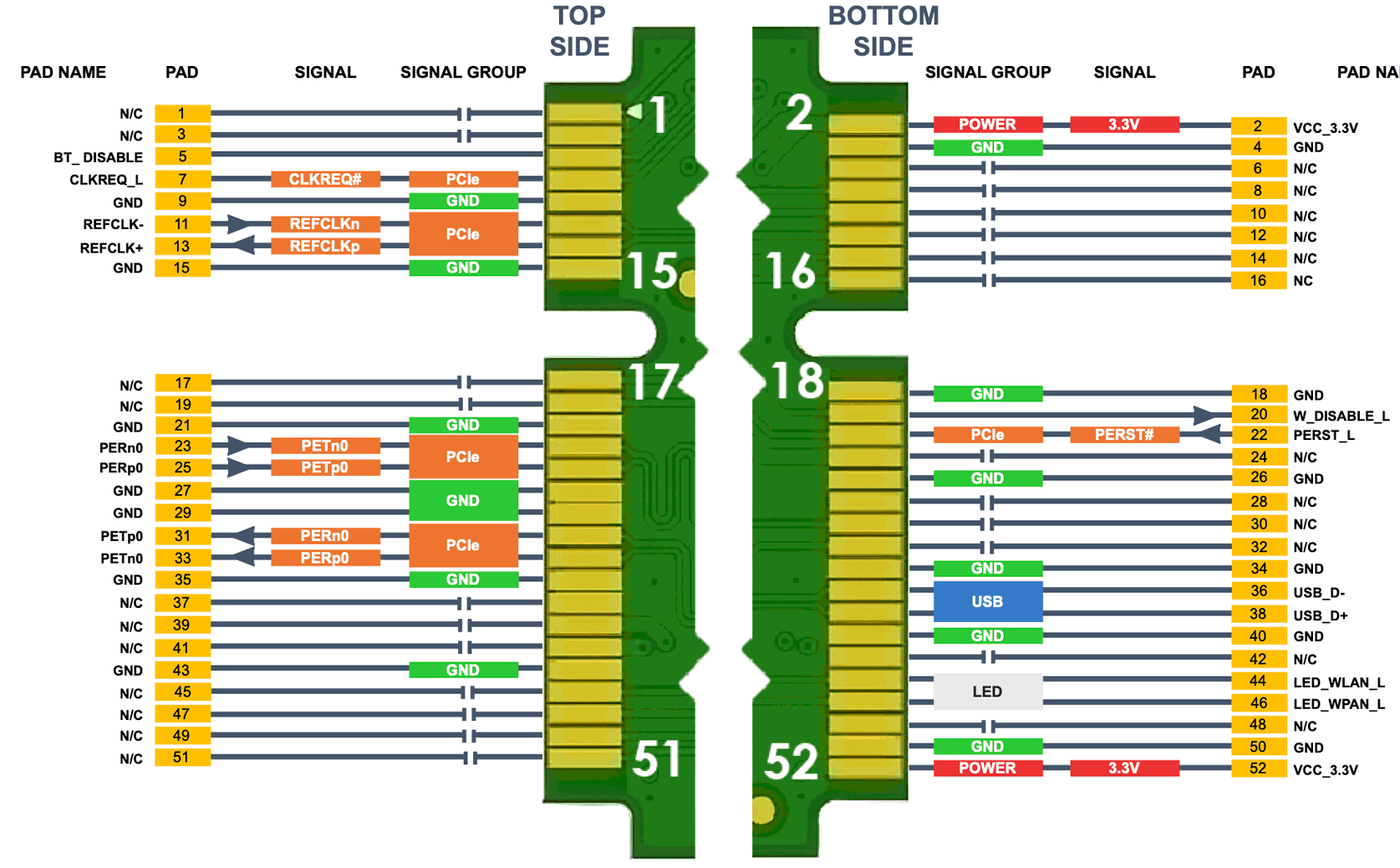SOLUTION DESIGN
Chipset: Qualcomm-Atheros combo AR9462-BL3A, AR9462-AL3A or AR9485-AL1A.
Standard: IEEE 802.11n Wi-Fi4, full backwards compatibility to previous standards
Industrial Reference: Follow Qualcomm Atheros reference designs WB222 and HB125
APPEARANCE
Communications Interface:
Pads at edge connector:
WLAN: via PCI Express Standard 1.1 host I/O
Form Factor:
Slotted, Socketed
ANTENNA
Configuration:
WLAN: Up to Two Streams (2 chains), 2x2 (1x2 for the AEH-AR9485), 2 Connectors, MIMO
Type:
Up to two on-board MHF1 Connectors.
WIRELESS PARAMETERS
Frequency Band:
WLAN:
2.4 GHz ISM Bands 2.412-2.472 GHz, 2.484 GHz
For the AEH-AR9462 only: 5.15-5.25 GHz (FCC UNII-low band) for US/Canada, Japan and Europe 5.25-5.35 GHz (FCC UNII-middle band) for US/Canada and Europe 5.47-5.725 GHz for Europe
For the AEH-AR9462 only: 5.725-5.825 GHz (FCC UNII-high band) for US/Canada
BT (AEH-AR9462 only): 2402MHz~2483MHz
Data Transfer Rates:
WLAN:
802.11n: Up to 450Mbps (dynamic)
802.11a/g: Up to 54Mbps (dynamic)
802.11b: Up to 11Mbps (dynamic)
BT (AEH-AR9462 only): 1 Mbps, 2Mbps and Up to 3Mbps EDR)
Media Access Control: CSMA/CA with ACK
Channel:
2.4GHz: 1-13 (14 only for Japan)
For the AEH-AR9462 only: 5GHz: 36-48, 149-165
Supports Fast Channel Switch (FTS): 1ms within and 2ms across bands
Channel Spacing: 10MHz and 20 MHz selectable
Spreading / Modulation:
WLAN:
802.11a/g/n: OFDM: BPSK, QPSK, 16-QAM, 64-QAM - DSSS: DBPSK, DQPSK, CCK
802.11b: CCK(11, 5.5Mbps), DQPSK(2Mbps), BPSK(1Mbps)
BT (AEH-AR9462 only):
Header GFSK
Payload 2M: 4-DQPSK Payload 3M: 8DPSK
RF Output Power:
802.11a (AEH-AR9462 only): Typical 11 dBm at 54M / 15dBm at 6M +- 2dBm
802.11b: Typical 17dBm +/- 2 dBm
802.11g: Typical 15 dBm at 54M / 17dBm at 6M +- 2dBm
802.11n 5G HT20 (AEH-AR9462 only): Typical 9 dBm at MCS7 / 14dBm at MCS0 +/- 2dBm 802.11n 5G HT40 : Typical 9 dBm at MCS7 / 14dBm at MCS0 +/- 2dBm 802.11n 2.4G HT20 : Typical 14 dBm at MCS7 / 17dBm at MCS0 +/- 2dBm 802.11n 2.4G HT40 : Typical 14 dBm at MCS7 / 16dBm at MCS0 +/- 2dBm
- The two chain combined output power equals to single chain power plus 5dB (2Tx = 1Tx + 3dB).
BT (AEH-AR9462 only): (Class 2 Device) -6 ≤ Output Power ≤ +7 dBm (Conductive)
RF Receive Sensitivity (Typical, 1x1 chain):
802.11a (AEH-AR9462 only): 54M less than 68 dBm
802.11b: 11M less than 78dBm
802.11g: 54M less than 68 dBm
802.11n 2.4G:
802.11n 5G (AEH-AR9462 only):
HT20 MCS7 less than 64 dBm
HT40 MCS7 less than 61 dBm
HT20 MCS7 less than 64 dBm
HT40 MCS7 less than 61 dBm
Operating Range:
Open Space: ~300 m; Indoor: :~100 m
(Coverage vary according to environment, antenna and topography)
Wireless Security:
WEP 64-bit and 128-bit encryption
WPA (Wi-Fi Protected Access)
WPA2 (Wi-Fi Protected Access)
MODALITIES
Infrastructure, AP/STA, Client, Bridge, Mixed-mode, P2P/Ad-hoc
SAFETY & REGULATORY
Almost 50 domain modular certification available, including FCC, CE, IC and TELEC (including optional MKK).
Compliant with RoHS3.
PROTOCOLS
IEEE WLAN Network:
IEEE 802.11a/b/g/n (Wi-Fi4),
IEEE 802.11d, 802.11e, 802.11h, 802.11j and 802.11i
Other Standards: (AEH-AR9462 only) Bluetooth 4.0 : Low Energy (BLE), High Speed (BHS), Enhanced Data Rate
(EDR)
Industry Standards: Wi-Fi CERTIFIED Direct®, Wi-Fi CERTIFIED Miracast®
HOST SYSTEM REQUIREMENTS
Operating System: Windows (32 & 64 bits) XP/Vista/7/8/10, OSX/macOS, Linux
Bluetooth (AEH-AR9462 only): Any upper layer Bluetooth stack. GNU/Linux BlueZ as the basis for its Bluetooth host stack.
** 30+ MB memory (RAM) is recommended for best performance.
ENVIRONMENTAL
Operating Temperature: -25 to +85 Celsius (depending on MPN)
Storage Temperature: -40 to +85 Celsius
Operating Humidity: 10% to 90% non-condensing
Storage Humidity: 5% to 95% non-condensing
ELECTRICAL
Power Consumption:
PROTOCOL RATE: 2x2 CTx 2x2 CRx
HT 40*: 269.1 mA max 149.94 mA max
• Electronic current values in milliampere. Readings retrieved under stable, typical current and voltage.
• Power consumption ratings are statistical maximums in test system setups which are placed in continuous operating modes.
• Real-life application system power budgets are dependent on traffic mix, environment, topology and domain configuration.




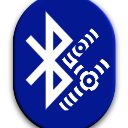



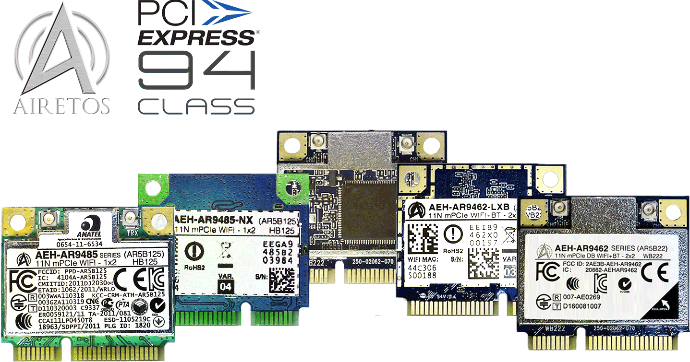

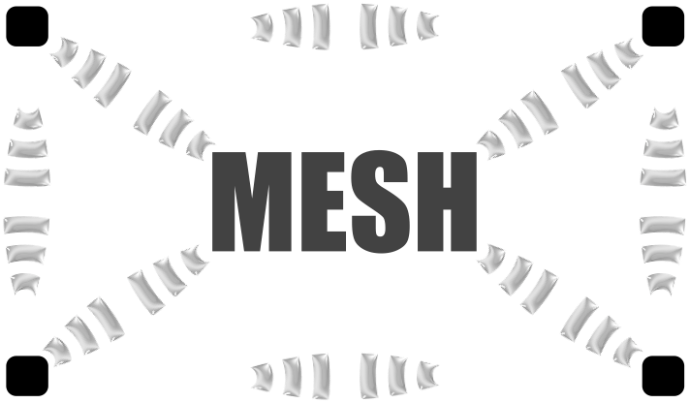


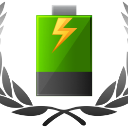



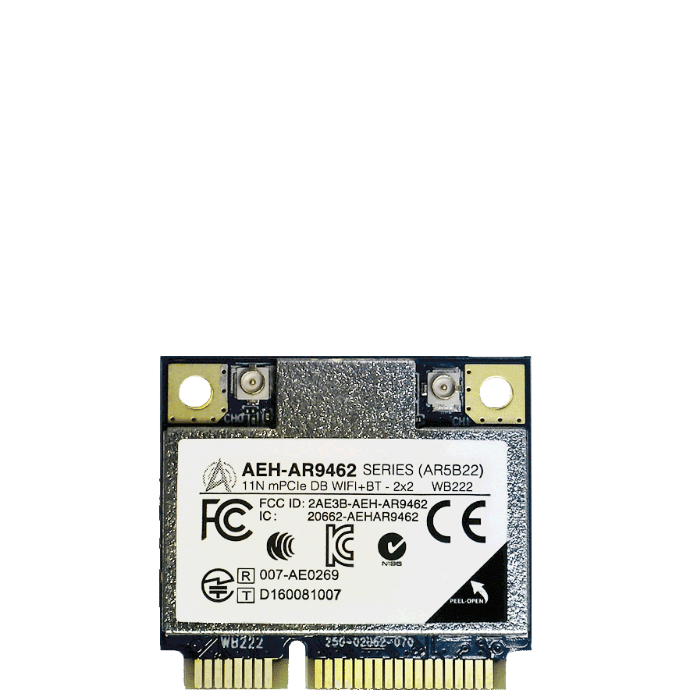
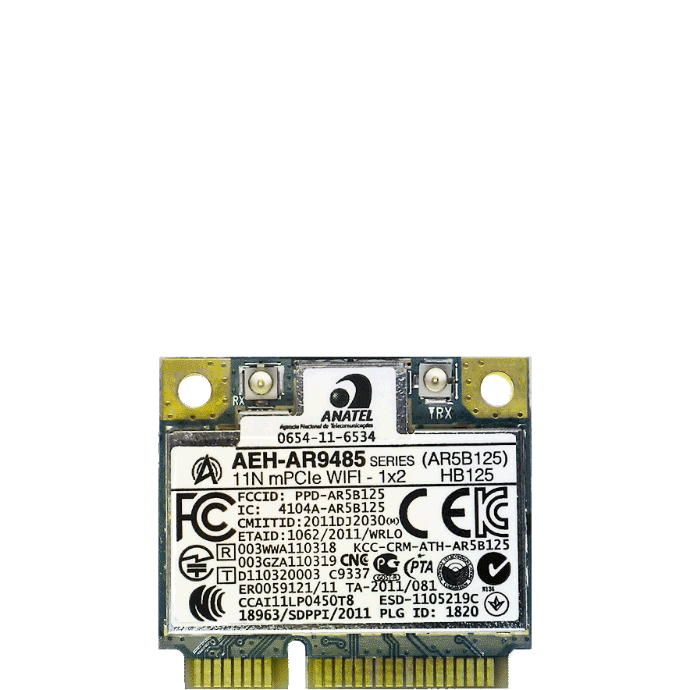

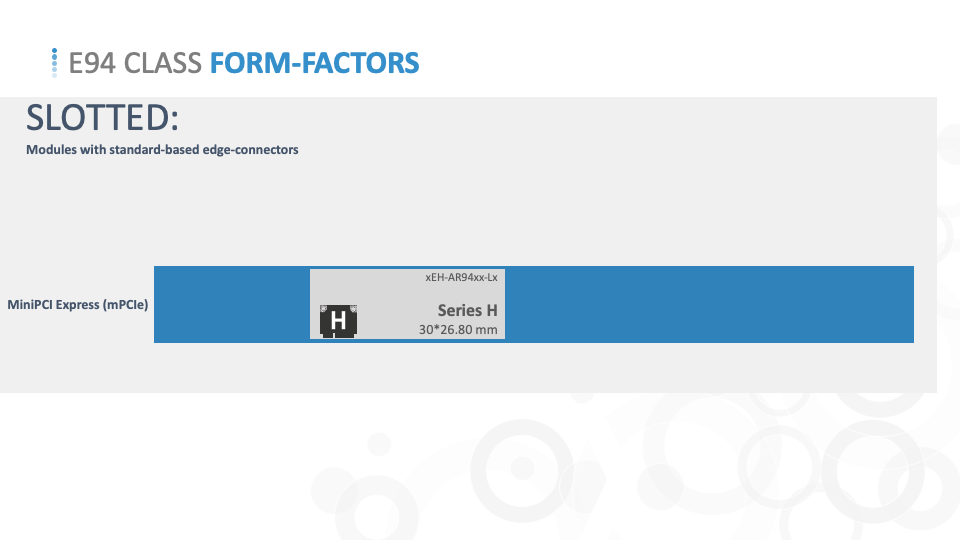


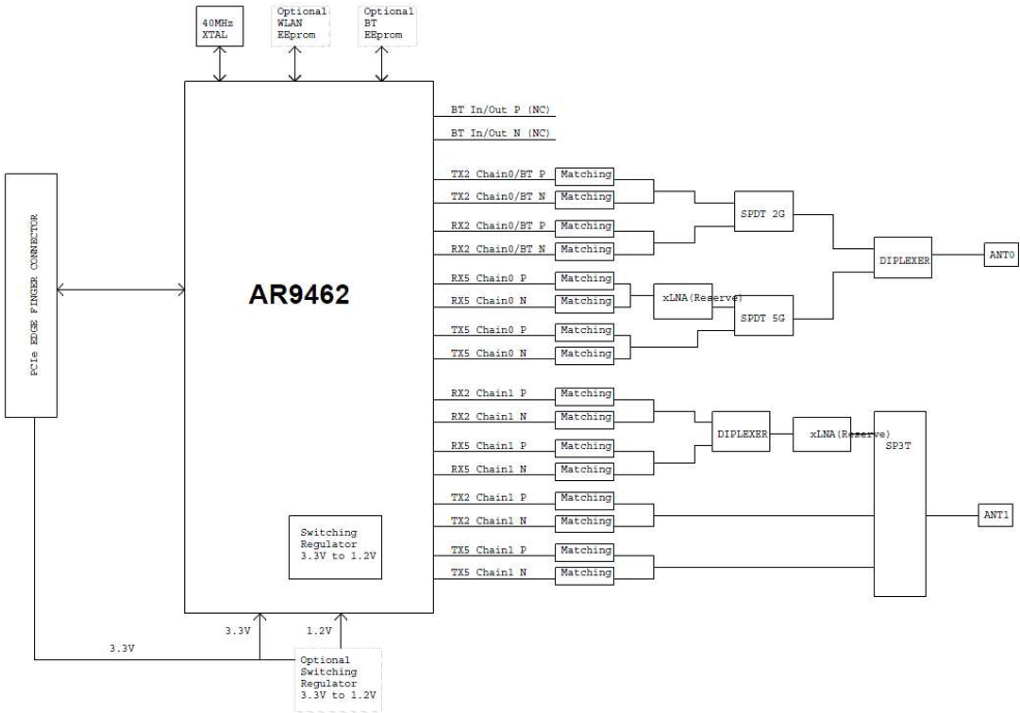 ** showing 2x2+BT combo E9462 Block Diagram configuration.
** showing 2x2+BT combo E9462 Block Diagram configuration.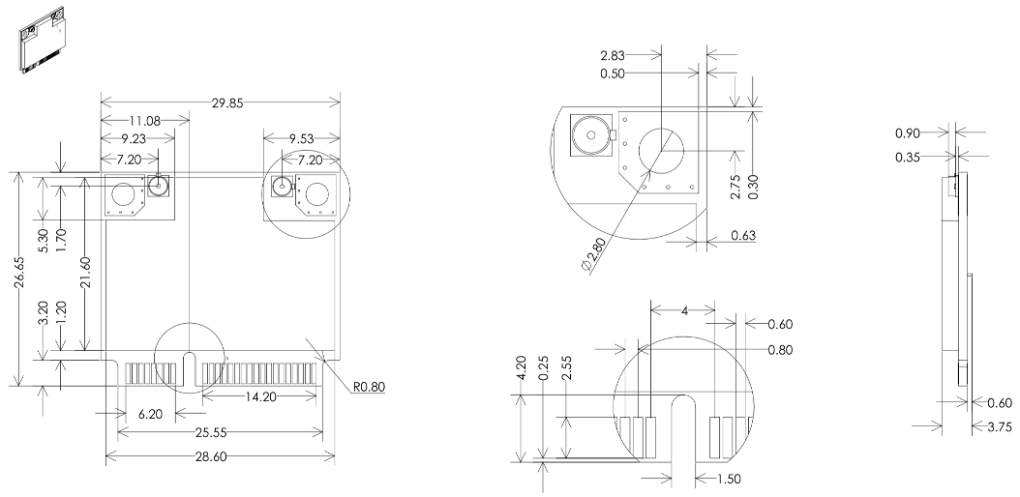 * showing 2x2+BT combo E9462 mechanical configuration.
* showing 2x2+BT combo E9462 mechanical configuration.